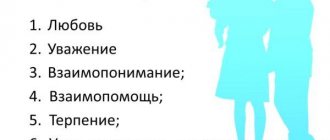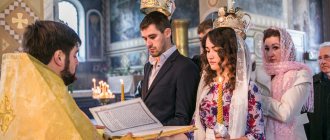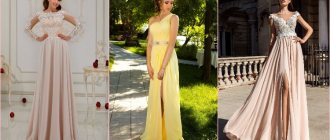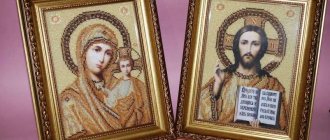In this article: #1 History of the towel #2 Folk signs of the towel #3 Types of towels #4 Sizes of towels The main wedding attribute is the towel. The tradition of using white embroidered towels in a marriage ceremony has a very long history. First, let's translate this word. It comes from the root “rukh”, “rush”, “destroy” which means to tear, break. That is, it turns out that a towel is a torn piece of fabric.
History of the towel
The history of the emergence of towels goes back far into the past. Wedding towels first appeared at matchmaking, then the girl embroidered them with her own hands and gave them to him as a sign of consent to become a wife. In the old days, about forty towels were embroidered for one wedding. In Rus', towels were embroidered by girls from an early age, and then this towel became a wedding attribute. After the wedding, the groom's parents greeted the newlyweds with a towel. The towel decorated wedding carts; they were placed on the backs of horses, towels were tied instead of a harness and presented to the groom’s relatives. On the towel, parents presented the wedding loaf and icons with which they blessed the newlyweds. During the wedding, the priest tied the hands of the bride and groom with a “towel of union,” symbolizing mutual affection and unity. The newlyweds' joint first step had to take place on the towel, and the one who first steps on it is considered the head of the family.
What to do with a towel after the wedding?
After the wedding, towels cannot be given to someone or thrown away if you do not want to lose a stable and happy family life. The canvases are carefully folded and stored as a keepsake of the past celebration. On anniversaries or anniversaries of marriage, they are taken out and decorated with the interior. , a loaf of bread is served on a towel .
Photo of a wedding towel for a loaf
In Rus', an elderly couple could give their wedding towel only to their children. This way the canvas could be passed on from generation to generation, especially through the female line.
After a divorce, you must decide for yourself how best to deal with the canvas. You can take the towel to church , where it will be useful for the baptism of orphans and low-income people. Or you can give it to someone who is going to perform a ceremony that will require a towel.
Towel under your feet
He is perhaps the most important person at the wedding ceremony, because it is he who decides how the future life of the new family will turn out. In the registry office during the marriage process or in the church during the wedding, witnesses spread a “wedding” white towel on the floor in front of the newlyweds, on which they stood. The center of the cloth should remain white, thereby personifying the connection with the cosmos. The towel symbolized a white cloud on which the bride and groom seemed to ascend to the Kingdom of Heaven, where the Lord himself blessed their marriage and sealed it with the sacred bonds of marriage. Therefore, it is forbidden to embroider rings, flowers, the wish “For good luck!”, or two birds symbolizing the newlyweds on it, because when the bride and groom stand on such a towel, they will trample on everything good that could be in their family future. The best option for embroidery on a wedding towel is a floral ornament or a geometric pattern. If a girl decides to embroider a towel by hand, then under no circumstances should her mother or sister help her, otherwise her son-in-law will be turned away (discouraged).
How to choose?
From whom to order a towel for a loaf (from a company or from a familiar embroiderer) is an individual question. The price of the work may not differ.
When choosing, follow simple principles:
- Towels with a colorful print should not smell like paint ;
- It is better to purchase from the moment you submit your application to the registry office. There are 2 explanations for this. Firstly, the bride will have other worries. Secondly, there is a possibility that the production of this accessory will have to wait a long time. We must take into account the seasonality of weddings;
- They don’t take used towels, which is considered a bad omen.;
- It is important that the length of the product is divided into 7 equal parts - this is required by custom.
Brides should take into account that the main advantage of a factory-made product is the guaranteed accuracy of the pattern on both sides. However, only a towel that has been custom embroidered by a master can be unique.
"Union" towel
The priest tied the hands of the newlyweds with this towel, as a symbol of the unity and affection of the bride and groom for each other; these towels bore the inscription “advice and love,” floral ornaments, doves, swans, rings that appeared only in the Soviet years, etc. A white or union towel embroidered with white threads - for a cloudless life, for joy - with red threads.
Elemental ornaments
Water and Sun. All embroidery is marked with the signs of the Sun and Water. These two elements created earthly life, so they must be understood as solar paternal energy and water maternal energy. An octagonal flower or rosette represents the Sun, and a curled one symbolizes Water.
Earth is a powerful symbol of fertility. Embroidered in the shape of a rhombus.
“Hospitable” towel or towel under a loaf
It is the brightest of all and there are no restrictions for it. On such a towel lay a wedding loaf with which the parents greeted the young couple after the wedding ceremony. The towel on the sides was decorated with the image of a pair of birds looking at each other, symbolizing happy newlyweds, sincere and faithful to each other in their future family life, inscriptions of wishes, floral ornaments symbolized wishes for prosperity and well-being. And the inscription on the towel “Bread and Salt” symbolizes prosperity and harmony in their family.
How much does it cost?
The price range for these accessories starts from 150 rubles on average (in Moscow) - this is color printing on a textile product, and from 300 - 700 rubles .
The splendor of the design, the quality and length of the canvas, and the fame of the manufacturer affect its cost. You can buy a towel for a loaf from a clothing factory for 1300 – 1800 rubles . When placing an order, production times are taken into account. Machine embroidery is done faster ( from 3 to 7 days , if it is not the height of the wedding season).
“God’s” towel or towel “under icons”
For the bride and groom, the ornaments on the towels under the Holy Faces are different. The only common element is grape leaves with clusters, symbolizing prosperity in the house. On the groom's towel, acorns and oak leaves are embroidered, which represent masculine strength, and on the bride's towel, lilies and viburnum are embroidered, symbols of beauty and procreation, respectively. Be sure to say a prayer before embroidering ornaments: “Creator and Creator of all things, O God, the work of our hands, which we begin for Thy glory, hasten to correct with Thy blessing, and deliver us from all evil, for one is all-powerful and Lover of mankind.” At the end of the work: “Thou art the fulfillment of all good things, my Christ, fill my soul with joy and gladness and save me, for I alone am merciful, Lord, glory to Thee.” Please note that the ornament pattern is at an angle.
Interesting video: how to embroider fabric yourself
If the bride decides to embroider a towel on her own, it is important to learn in advance about the features of embroidery, the intricacies of creating the product, and popular mistakes made by needlewomen. This will allow you to choose the right pattern, fabric, threads, embroidery technique, and product size.
It is also important to know how to embroider patterns, what the back of a towel should be like so that it looks perfect. You can learn from your experiences and make mistakes. Or you can watch a video several times about how experienced needlewomen embroider products. And create a towel for a loaf of bread with your own hands.
Without errors and with a perfect backside:
Chic wedding towels for a loaf can be made using the diagram below:
Sizes of towels
According to tradition, the size of a wedding towel is divided by 7 without a remainder. The length is divided into three equal parts and the middle, one third, must be left white. Nowadays, few people adhere to this rule and choose a white canvas 2 to 3 m long for towels “under the loaf” and “under the feet”. But in the center there must be an empty space for the bride and groom to step into, and plus the rule of the design quarters of the towel, so the length in width is from 45 to 50 cm. The width of the towel is determined by repeating the pattern, and the length is determined by the amount of embroidery (the free space in the middle should be enough for the feet of the newlyweds). The towel is hemmed by hand, grasping the base thread through the cross, so that a dotted line is created on the face only if a fabric without an edge is used for it. The hem depends on the fabric, for example, calico or linen is folded 0.5 cm 2 times. The design should be symmetrical and there should be no white border on the sides. The sizes of towels “for icons” and “union” are: length from 1.8 to 2 m, and the width of the towel depends on the pattern.
We recommend that you read:
Wedding towel and embroidery symbols
Towel for a wedding: what to do with a towel after the wedding
Towel for loaf. What is this?
What is called a towel in Russia, in the Ukrainian version sounds like “rushnik” : from the word “to destroy”, “to tear”. There is another meaning of the word – “to move”, so the ritual towel among the Eastern Slavs is a symbol of the path.
The towel has always been a mandatory attribute of a wedding , as it became the personification of a successful path into family life. Today it is a decorative element into which newlyweds continue to invest sacred meaning.
Story
This ancient accessory appeared long before the Christianization of Rus'. It was believed that by embroidering certain patterns on a linen or canvas piece of fabric, one could protect Rod from the evil eye. Such a talisman for the family promised prosperity, fidelity, health, and the birth of children. There was a special approach to wedding towels.
Initially, the future bride was required to embroider up to 40 ritual towels with her own hands. They were given to matchmakers, guests - at the time of matchmaking, at a long marriage ceremony (a wedding in some regions could be celebrated for a week).
Below, in the “Types of towels” section, we will analyze the types of towels and answer the questions - which towel is needed for an icon, and which one is needed when meeting young people with a loaf of bread.
This is interesting! There was a certain minimum. The girl had to embroider at least 12 towels . The rest was done by the women of her family - so that they would not think that the potential wife was lazy and impatient. The most magnificent in decoration and abundance of design was the towel for the loaf.
Why you shouldn't follow superstitions
Superstitions are inherent in any ritual. And a wedding is no exception. Therefore, weddings also have signs and superstitions. But you shouldn’t believe or hope for them.
They do not guarantee the fulfillment of a particular prediction. But they only increase the likelihood of a similar outcome of this or that action in the life of a couple.
Everyone decides for himself what is a sign for him and what is superstition, what to believe and what not.
But it is important to know the key wedding signs that are important to remember during the wedding preparations and find out what the popular superstitions are and not give in to panic. This will create the perfect wedding, filled with positive emotions, fun and joy.
It is easy to distinguish signs from superstitions. It is enough to turn on logic and think about what is the basis for the emergence of a belief. Fear or desire to observe favorable traditions? Previously, people tried to observe the peculiarities of wedding rituals, so they knew the key signs and studied the symbolism of the signs.
The signs are varied. The most popular are the following.
- The groom should not see the bride's dress before the wedding;
- The length of the dress is the length of the married life;
- Before the wedding, the couple needs to eat one dessert for two, then the lovers will live amicably and prosperously;
- When the ransom is completed, the outfit of the bride and groom must be connected with a pin (and not separate the couple in love until the place where the marriage is registered);
- Previously, some time before the start of the ceremony, it is necessary to cover the bride’s face with a veil, this will protect her from the evil eye;
- When the groom takes the bride from her parents' house, the girl's mother washes the floors - this means an easy road to the new home (there is no need to wash the threshold, this promises a quick return to her parents);
- The bride's outfit must be one piece (if there is a separate skirt and corset, this promises an unhappy married life);
- There will be no quarrels if, before entering the couple’s house, the newlyweds break a plate “for luck”, hold hands and step over the pieces together;
- A couple will live comfortably if they are showered with money and wheat upon leaving the wedding venue.
- Particular attention was paid to the date of the celebration. It was believed that the best days were the 7th, 12th, 3rd, 5th, and 9th of the month.
- The 13th was considered unlucky and predicted failure for marriage.
- Rings were also given special significance. Read more about choosing by following the link.
Interesting!
Magical meaning
The purpose of the towel depends on its color, embroidery and the nature of the ornament, the location of its individual elements, which in general has a magical meaning:
On the towel under the feet, on which the newlyweds stand during the wedding, there should not be images of swans, wedding rings, flowers or doves.
It was believed that young people could trample on their future happiness. The presence of floral or geometric textures is welcome.
To bless parents for the marriage of their children, patterned towels with unique bright red embroidery are chosen.
Moreover, the so-called god personifying the groom has images of grape vines and oak leaves, and for the bride, bunches of viburnum and lush roses are woven on the canvas.
The names of the newlyweds with wishes, as well as swans symbolizing fidelity and happiness, wedding rings are decorated with towels for tying the hands of the bride and groom in the registry office or church.
Here it is allowed to use any colors of threads, but the predominant color should be red, denoting love, beauty and fullness of life.
Be sure to greet the married couple with a wedding loaf with a hospitable towel.
This type of canvas is characterized by the absence of restrictions, since it can be decorated with any textures, ornaments and patterns, for example, flowers, leaves, trees, wedding rings, wishes to the newlyweds or images of animals and birds.
Thus, among the most popular symbols depicted on the towel are roses, denoting rebirth, eternity and the sun, doves, associated with peace and happiness, lilies, which are a sign of virgin beauty, innocence and purity, bunches of grapes, carrying a charge of wealth, family well-being and fertility , large families.
Tree images personify the connection between generations and clans, peacocks - renewal, development and progress, viburnum - female beauty and immortality, and the rooster symbolized health, hard work and prosperity.
Crocheting patterns for towels
Crochet lace for a towel is used as a border. The pattern is usually knitted separately and then sewn to the finished embroidered towel. Crochet patterns can be found in specialized magazines or on the Internet.
How to knit a pattern for a towel, watch the video.
Using a towel for weddings is an old tradition that dates back to ancient times. In the future, the towel is kept by the husband and wife throughout their life together. It cannot be re-gifted or used in everyday life.
Step-by-step instruction
For beginner craftswomen, it is better to try your hand at cross stitch.
To make the embroidery symmetrical and neat, you need to mark it . For a towel, it is better to start work from the middle. To do this, fold the selected piece of fabric (blank) in half lengthwise and smooth the fold . You can mark the middle with a simple pencil or a washable marker.
DIY embroidery. Main stages of work:
- Select a pattern. The edges (border) and part of the fabric above are embroidered on towels. Approximate sizes and possible locations of motifs are shown in the diagram. You can download the diagrams in the section below.
- Calculation of the number of repeating sections (rapports) according to the diagram. Fragments can be marked on the canvas by counting out the required number of cells. It is also convenient to draw the outline into squares of 10 cells.
- Installing the hoop
- Securing the first thread.
- Sequential creation of patterns. For a long row, stitches are first laid in one direction, and in reverse in the other direction. Single crosses are embroidered immediately.
Important : knots are not allowed in ritual embroidery! The thread at the beginning and end is secured by pulling, entwining other threads, but not with a knot.
After creating the main pattern, you need to process the edge . To do this, the fabric is folded in half and hemmed with hidden stitches. It is convenient to combine the hem with an additional decor - hemstitching.
You can use hemstitch to decorate the cross-stitched pattern on top and to separate the stripes of the ornament. Instead of decorative hemming, lace is often used at the edges .
The finished work is washed in water acidified with vinegar (this makes the color of the dyed threads more stable) and steamed.
Embroidery of a wedding towel with beads
Towels embroidered with beads look very beautiful. For independent work, you will need to purchase fabric, a needle, a set of beads of the desired color, threads and other accessories.
You can find ready-made kits so you don’t have to buy the items you need yourself.
The pattern will look neat if all the beads have the same diameter . The highest quality in this regard is Czech or Japanese beads.
Most often, ceramic or glass beads . It is better to buy ceramic, as it does not lose color when washed or rubbed. The same cannot be said about glass beads.
Towel for wedding with beads
To embroider a wedding towel you will need silk or cotton threads . They are good because they do not stretch and have increased density. Polyester threads and those impregnated with wax are also suitable. The color of the thread is matched to the shade of the fabric or beads. The needle used is thin, with a small eye (No. 12).
Adviсe
There is an opinion that those who do not know about superstitions or signs are not subject to their influence. But psychologists note that the influence of signs and superstitions is directly related to what a particular person believes. Therefore, superstitions are not true.
People give them power. Some are afraid of something, while others boldly set their wedding day on the 13th and live happily for many years. When listening to superstitions, it is important to hear, first of all, yourself.
Does the superstition or sign resonate with your way of thinking? If yes, and you are happy with it, then you don’t need to do anything about it. And if superstitions and signs interfere with living and preparing for the wedding, you should think about whether extraneous observations and fears take up too much space in your life?
admin 115
Previous article
Modest, but not cheap - a small wedding cake without mastic and with its use
Next article











